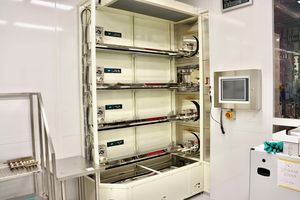Difference between revisions of "Sandvik Furnace Stack"
| Line 49: | Line 49: | ||
==== Deposition and growth rate ==== | ==== Deposition and growth rate ==== | ||
* Thermal Oxide growth rate is not constant. Please use online calculators to get an estimate | * Thermal Oxide growth rate is not constant. Please use online calculators to get an estimate | ||
| − | * LPCVD nitride deposition rate using the standard recipe: ~ 480 nm/ | + | * LPCVD nitride deposition rate using the standard recipe: ~ 480 nm/hour |
Revision as of 14:05, 17 October 2023
 |
|
| Tool Name | Sandvik Furnace Stack |
|---|---|
| Instrument Type | Deposition |
| Staff Manager | Sam Azadi |
| Lab Location | Bay 2 |
| Tool Manufacturer | Ultratech/Cambridge |
| Tool Model | S200 |
| NEMO Designation | {{{NEMO_Designation}}} |
| Lab Phone | 215-898-9736 |
| SOP Link | SOP |
Description
The Sandvik LPCVD consists of 4 furnace tubes, with maximum temperature of 1050 C for each one:
Tube 1: Wet/Dry Silicon Oxide growth. Wet/Dry oxide: This tube uses the Si substrate to grow SiO2. Wet oxide refers to the use of water vapor as the source of oxygen and dry oxide uses O2 gas. Since water molecules can penetrate through the substrate more, wet oxide technique results in thicker oxides and faster growth rate. Wet oxide deposition on the tool is limited to 5 hours.
Tube 2: Low Stress Silicon Nitride deposition. This tube is designated to low stress silicon nitride.
Tube 3: Clean anneal. This tube is an RCA clean wafer only anneal tube, with N2 and H2N2 gases.
Tube 4: General anneal. This tube is a general anneal tube, with N2 and H2N2 gases
Applications
- Wet/Dry Silicon Oxide growth
- Low Stress Silicon Nitride deposition
- Annealing with N2 or H2N2 gases
Resources
SOPs & Troubleshooting
Process information
Deposition and growth rate
- Thermal Oxide growth rate is not constant. Please use online calculators to get an estimate
- LPCVD nitride deposition rate using the standard recipe: ~ 480 nm/hour